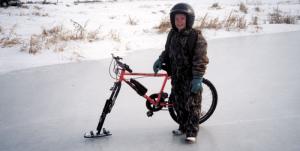"Ice Bike" Great For Frozen Ponds
 ✖  |
"I recently modified my grandson's 10-speed bike so he can ride it on frozen ponds and lakes. I simply put an ice skate blade on front and left the original rear wheel in place. But I put several dozen small bolts through the rear tire for traction. It's amazing how well it works," says Harold Fratzke, Cottonwood, Minn.
Fratzke bolted the skate blade to a 10-in. long metal bracket that bolts onto the bike forks. He removed the rear wheel and drilled a series of holes in the tire. He inserted bolts through the holes from the inside of the tire and put the nuts on from the outside. He also "jimmied" the bolt threads so the nuts can't come off. The nuts are spaced in a zig-zag pattern about 2 in. apart.
"I call it an Ice Bike. It handles as well as a conventional bike so you can really go," says Fratzke. "I sharpened the skate edge to a V so it bites into the ice better when turning. Because the skate is sharp, there's very little friction on the ice so it steers just like a regular bike. The studs in the rear wheel provide so much traction that the rider can't even spin the wheel on ice. The nuts also keep the wheel from slipping when turning. The rider doesn't really feel the studs that much because they're spaced fairly close together.
"To switch back to summer riding, I just remove three bolts to take the skate bracket off. Then I put the original wheel back on."
Contact: FARM SHOW Followup, Harold Fratzke, 234 Shoreview Drive, Cottonwood, Minn. 56229 (ph 507 423-6341; E-mail: hnl@starpoint.net).

Click here to download page story appeared in.
Click here to read entire issue
"Ice Bike" Great For Frozen Ponds FARM HOME recreation 26-2-44 "I recently modified my grandson's 10-speed bike so he can ride it on frozen ponds and lakes. I simply put an ice skate blade on front and left the original rear wheel in place. But I put several dozen small bolts through the rear tire for traction. It's amazing how well it works," says Harold Fratzke, Cottonwood, Minn.
Fratzke bolted the skate blade to a 10-in. long metal bracket that bolts onto the bike forks. He removed the rear wheel and drilled a series of holes in the tire. He inserted bolts through the holes from the inside of the tire and put the nuts on from the outside. He also "jimmied" the bolt threads so the nuts can't come off. The nuts are spaced in a zig-zag pattern about 2 in. apart.
"I call it an Ice Bike. It handles as well as a conventional bike so you can really go," says Fratzke. "I sharpened the skate edge to a V so it bites into the ice better when turning. Because the skate is sharp, there's very little friction on the ice so it steers just like a regular bike. The studs in the rear wheel provide so much traction that the rider can't even spin the wheel on ice. The nuts also keep the wheel from slipping when turning. The rider doesn't really feel the studs that much because they're spaced fairly close together.
"To switch back to summer riding, I just remove three bolts to take the skate bracket off. Then I put the original wheel back on."
Contact: FARM SHOW Followup, Harold Fratzke, 234 Shoreview Drive, Cottonwood, Minn. 56229 (ph 507 423-6341; E-mail: hnl@starpoint.net).
To read the rest of this story, download this issue below or click
here to register with your account number.







